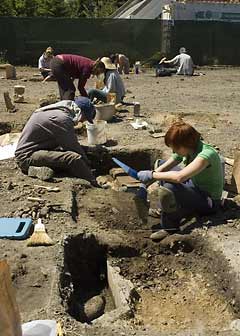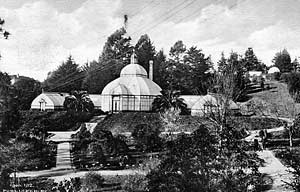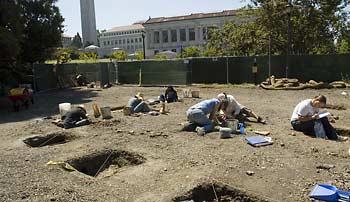UC Berkeley Web Feature
Students dig up a piece of campus past
 Students from Prof. Laurie Wilkie's methods in archaeology class get down and dirty in order to retrieve artifacts from the UC Conservatory. (Photos by Wendy Edelstein / UC Berkeley) |
BERKELEY – Summer Session anthropology students got to learn the rigors of field work without leaving the Berkeley campus this month as they excavated the site of the University of California Conservatory, razed more than 80 years ago.
From May 23 to June 17, Laurie Wilkie, an assistant professor of anthropology, led the 24 students enrolled in Anthropology 133: Methods in Archaeology at the dig, on the site of the former Haviland Hall parking lot. The students dug through multiple layers of asphalt on sun-baked days, and reaped the benefit when June rains softened the hard, clay-like soil.
The class was taking advantage of a small window of time before construction begins on the C.V. Starr East Asian Library Study Center, which will be situated on the site near Memorial Glade.
The university wasn't legally obligated to perform archaeology at the location. "This research represents a new recognition on the university's part that there is an extensive cultural heritage that needs to be considered in the course of development," said Wilkie.
The archaeology project is being funded by the anthropology department and Summer Sessions. Facilities Services has underwritten part of the staffing for the field work and will provide funding for the analyses of the artifacts.
 This image from an old postcard shows the UC Conservatory in its prime. |
The UC Conservatory, completed in 1894, was torn down in 1924. "In the mere 30 years of its existence, the UC Conservatory went from being seen as a necessary component of the university to being a glass white elephant requiring demolition," said Wilkie.
How that shift in perspective took place was one of the driving questions behind the archaeological research. The glass house, as the UC Conservatory was sometimes known, was modeled after the Conservatory of Flowers in Golden Gate Park. (Wilkie theorized that the Conservatory's Victorian architecture was too antiquated for a university trying to promote itself as a modern research institution.)
In the late 1880s, agriculture professor Eugene Hilgard lobbied the UC Regents for the conservatory's construction and was closely involved in its planning. Hilgard, regarded as the father of soil science, even traveled to Europe in 1893, delaying work on the project while he inspected prominent conservatories across the continent.
The UC Conservatory was comprised of a central palm house, with adjacent east and west wings. For the Summer Sessions dig, the undergraduate students separated into groups to excavate various parts of the structure - the cellar, potting shed, boiler room, and the palm house. Ironically, Haviland Hall's parking lot preserved organic materials that had been buried beneath its surface.
 At the Conservatory dig site, just north of Memorial Glade, archaeology students record their finds in field journals. |
The students dug up a number of artifacts associated with a plant conservatory - thermometer fragments related to controlling the temperature of the various houses, flower pots of various sizes, several plant tags, glass droppers presumably relating to mixing chemical additives for soil, and a range of Mason jars the public may have donated for storage of specimens or chemicals. Those Mason jars exemplify the juxtaposition of the Victorian-era predilection for collecting with the scientific inquiry taking place at the Conservatory, said Wilkie.
The students learned that during the Conservatory's demolition, the boiler room was used as a dumping ground. They found rubble from the building there, including iron framing from the structure, slate from plant tables, a decorative hanger, and a range of pots. Beer bottles, whiskey flats, and dairy bottles turned up in the boiler room as well, possibly tossed in by the demolition crew.
Wilkie said the class was surprised to unearth an odd collection of ceramic tableware, including teacups, plates, bowls, pitchers, pots and lids, crocks, pie plates and a large platter. She speculates that some of these pieces may have been used as pots and draining bases for plants, while the cups could have been used to scoop soil or fertilizers.
The class made some other unusual discoveries including glass beads, a watch-chain loop, a number of marbles, and a National Guard button - items that attest to the Conservatory's use as botanical garden where visitors could view exotic plants as well as a place for research and instruction, says Wilkie.
While the field work has ended, analyses of the materials from the site will take place over the next year.
The excavation is the third that Wilkie has led on campus. She worked on an advance dig of the Conservatory excavation in 2003, before the parking lot was removed. In 1996, she led an excavation of the former Zeta Psi fraternity house on College Ave.
Wilkie views the Conservatory excavation as an important milestone. "We have a rich historical and archaeological legacy preserved on this campus, and development and preservation do not have to be in opposition, but can be meaningfully integrated for the good of the university and the surrounding communities."

